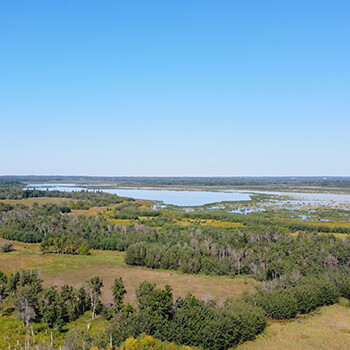The State of the State of the Biosphere

With the ten-year anniversary of the Biosphere only a few years away, the Beaver Hills Biosphere has begun working on producing a State of the Biosphere report, to inform UNESCO’s 10-year review of the Biosphere, and to engage stakeholders, funders and the public, offering a birds eye view of the work we’ve done, and how far we’ve come as an organization.
Erin Anderson, who we welcomed to the Biosphere team earlier this summer, is currently researching and drafting the State of the Biosphere – and she’s really excited about it.
Reports normally take the form of a long, dry PDF. But for the public, eager to learn more about the Biosphere and its progress, reading a document isn’t always accessible. Instead, the public facing report will take the form of an ArcGIS StoryMap, allowing everyone to explore the Biosphere in their own way.
“People will be able to zoom in to certain parts of the Biosphere and learn about what’s going on there, or look at specific aspects like wildlife or culture,” Erin explains.
“It’s going to be interactive and clickable, so the public can explore the State of the Biosphere in their own way.”
Erin is particularly excited for the possibilities of the map to show change over time. Compared to a decade ago, how is this particular wetland doing? How have things improved?
“It’s going to be a great way for people to see the impact the Biosphere has had,” she adds.
The report isn’t meant to be a back patting retrospective on the Biosphere’s work – it's an opportunity to identify gaps in data, or places where goals haven’t been met yet, as well as celebrating the organization's progress on our goals.
The Biosphere’s projects and programs, including the Wetland Inventory, the Rural Residential Stewardship Program and the Wetland Conservation & Stewardship Pilot Project, will be evaluated. The report will evaluate how these programs have supported the Biosphere’s goals to build a healthy environment and healthy community, build capacity throughout our network and work to fight climate change through research, education and awareness.
The project has helped Erin learn a lot about the Biosphere, too. She’s grateful to have started her work with the Biosphere researching this project, getting acquainted with the Biosphere’s work and the area itself.
“I hope that the public learns something about all that we're doing. The Biosphere has such a wide scope that sometimes people don’t realize just how much we do or how much is going on,” Erin says.
“So, I really hope that this is an insightful look at what we're doing, and it informs our future decisions internally, too.”
It is great that BHB is planning this process. It is not clear from your short discussion here how various constituents will be involved in the process. Will you be producing a draft response to the UNESCO review questionnaire and then asking for people's input? Global Foundation
Lucien Royer
PostedI will be interested in seeing how you address the challenges of declining water levels in cooking Lake ( the largest waterbody in the BHB), which is now at the lowest level in recorded history
Mike Boyd
PostedI love the idea of a public facing report! I live in the Biosphere and often wonder how many people who live here read the newsletter or are aware of where they live. I also notice that in the eastern side of the biosphere, many of the long time owners are selling their land and newer, younger people are moving in. I have talked to a few and found they know nothing of the biosphere. I think some sort of a welcome to the biosphere strategy is needed, to make people aware of the goals and to share the tools available and things to consider BEFORE people start developing their new land acquisition. Maybe a partnership with the realtors that sell in this area? Definitely much better signage on Highway 16, Baseline and Wye Roads letting people know they have entered the BIOsphere.
Joan Maisonneuve
PostedLooking forward to this report! It will be a good tool for the people and organizations working in the Beaver Hills to conserve, enhance, and restore ecological integrity while also promoting community. I hope there will be some good information with regards to the state of the watershed/hydrology of the BH included.
Michael Pyska
PostedThank you to everyone who commented. We will be providing regular updates as the project progresses and we will be engaging constituents through community outreach. We intend to explore the issue of declining water levels through the upcoming Surface Water Community of Practice, which will then help integrate the topic into the State of the Biosphere. Watershed/hydrology information will also be included in the State of the Biosphere and will also be linked to the Surface Water Community of Practice. We are working with partners in the Biosphere to continually raise awareness and encourage people to sign up for the newsletter and follow social media to get more involved.
Beaver Hills Biosphere
PostedCan someone tell me of the progress of this work and the involvement of the public in its undertakiing ?
Comments